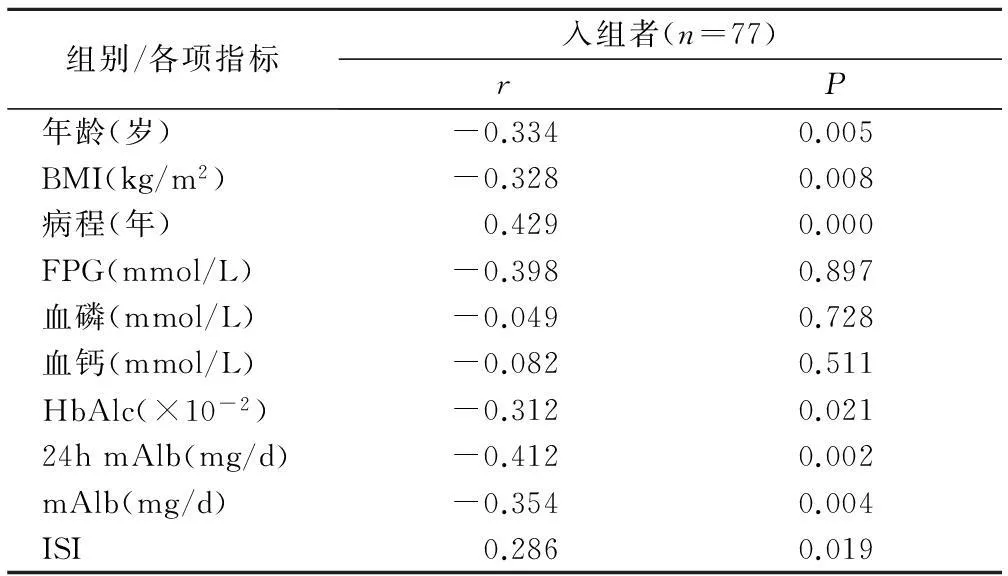老年Ⅱ型糖尿病患者并发骨质疏松的危险因素研究*
阎燕 尹红军 刘红珍
(新疆兵团第七师医院预防保健科,新疆 奎屯 833200)
·论著·
老年Ⅱ型糖尿病患者并发骨质疏松的危险因素研究*
阎燕尹红军刘红珍
(新疆兵团第七师医院预防保健科,新疆 奎屯 833200)
【摘要】目的探讨老年Ⅱ型糖尿病(T2DM)并发骨质疏松症(OP)的危险因素,为老年T2DM患者防治骨质疏松提供理论参考。方法分析2010年4月~2013年7月来院接受治疗的老年T2DM并发OP患者77例的临床资料进行分析。根据骨密度(BMD)值将患者分为骨质疏松组(OP组)45例和非骨质疏松组(NOP组)32例。另选正常体检30例作为对照组,比较三组患者在性别、年龄、BMI、病程、HbAlc、24h mAlb、mAlb、ISI以及BMD等指标上的差异。结果OP组和NOP组在FPG、血磷及血钙组间比较均无统计学差异(P>0.05);但在性别、年龄、BMI、病程、HbAlc、24h mAlb、mAlb、ISI及BMD组间比较,差异均有统计学意义(P<0.05);OP与NOP组患者的FPG、HbAlc、24h mAlb、mAlb均显著高于正常组,而ISI、BMD水平则低于正常组。病程、年龄、24h mAlb、mAlb以及HbAlc与BMD呈负相关关系;而ISI、BMI与BMD呈正相关关系(P<0.05);血磷、血钙、FPG与BMD的相关性不显著(P>0.05)。结论老年T2DM患者发生OP与多种因素相关,女性、高龄、病程较长、BMI低、血糖控制不佳、肾功能受损等均是发生OP的易患因素。
【关键词】Ⅱ型糖尿病(T2DM);骨质疏松症(OP);老年;危险因素
Ⅱ型糖尿病(T2DM)患者和老年人群均容易患骨质疏松症(OP),易导致骨折,出现较高的致残率,患者的生活自理能力丧失或降低,严重时会危及生命,使患者经济负担加重。糖尿病患者的糖代谢表现异常,能通过各种途径对骨代谢形成影响,进而引发OP,且T2DM的骨量降低[1]。老年T2DM合并OP患者早期可无临床症状,因此往往容易被忽略,直至中后期才会有骨折、畸形、骨骼疼痛等症状出现,一旦发生骨质疏松,无法逆转,故早期预防尤为关键[2]。本文旨在通过老年T2DM并发OP患者的发生率,以及OP与性别、年龄、体质量(BMI)等相关性因素的分析,为早期临床诊治提供参考。
1资料与方法
1.1研究对象分析2010年4月~2013年7月接受治疗的老年T2DM 77例患者的临床资料。入选患者年龄均>60岁,参照世界卫生组织(WHO)1999年制定的关于糖尿病诊断的相关标准[3]。入组患者不包括在最近3个月内曾服用激素类药物和钙剂、维生素D、二磷酸盐等对骨代谢有影响的药物等的患者。年龄平均73.1岁;女性35例,男性42例;病程平均12.5年。排除继发性OP(如肝脏肾脏疾病、结缔组织病、血液病等)、其它急性并发症及糖尿病酮症。
1.2研究方法骨密度(BMD)的测定:股骨颈和腰椎BMD的测量采用双能X线BMD仪,参照WHO于2003年制定的关于骨质疏松的相关诊断标准[4],将患者分为OP组(骨质疏松组,骨密度(BMD):T-Score≤-2.5SD者)45例和NOP组(非骨质疏松组)32例,并选取正常体检者30例作为正常对照组。
测定生化指标:采用TBA120FR型全自动生化分析仪对血磷、血钙、糖化血红蛋白(HbAlc)和空腹血糖(FPG)进行测定;采用放射免疫法对空腹胰岛素(FINS)和C-肽进行测定,依据胰岛素敏感性指数(ISI)=1/[FPG(mmol/l)×FPI(空腹血浆胰岛素)(IU/L)];24小时尿蛋白定量(24h mAlb)用磺胺水杨酸法测定;将晨尿留取,使用放射免疫法对尿白蛋白定量(mAlb)进行测定。

2结果
2.1三组患者各项指标比较结果提示,OP组和NOP组患者在FPG、血磷及血钙方面的组间比较均无统计学差异(P>0.05);但在性别、年龄、BMI、病程、HbAlc、24h mAlb、mAlb、ISI以及BMD方面两组的组间比较,差异均有统计学意义(P<0.05);OP与NOP患者的FPG、HbAlc、24h mAlb、mAlb均显著高于对照组,而ISI、BMD水平则低于对照组,见表1。

表1 三组患者各项指标的比较
注:与NOP组比较①P<0.05,与对照组比较②P<0.05
2.2OP的相关因素分析结果提示病程、年龄、24h mAlb、mAlb以及HbAlc与BMD呈负相关关系;ISI、BMI与BMD呈正相关关系(P<0.05);血磷、血钙、FPG与BMD的相关性不显著(P>0.05),见表2。
3讨论
老年人发生骨质疏松的几率约为55%[5]。本文提示老年T2DM并发OP患者的发生率可达58.44%,也证实了糖尿病会使骨质疏松发生率显著增加[6]。本实验针对老年T2DM并发OP的相关因素的分析结果发现,病程、年龄、24h mAlb、mAlb以及HbAlc与BMD呈负相关关系;ISI、BMI与BMD呈正相关关系;血磷、血钙、FPG与BMD的相关性不显著。糖尿病致使BMD降低的机制较为复杂,通常是多种因素的共同作用结果:高血糖会引发渗透性利尿,增加钙、磷的排出量,而高尿糖阻断了肾小管重吸收钙、磷的可能性,使钙、磷的丢失量增加;低血钙对甲状旁腺激素进行刺激,使其分泌量增加,加快了骨质的吸收,进一步使BMD降低[7];患者长时间的高血糖会让糖尿病者机体内形成大量的糖基化的终末产物,进而使破骨细胞对骨吸收的诱导作用增强[8];并发糖尿病肾病的同时,肾小管减少了对钙的重吸收量,继发性甲状旁腺功能亢进和肾1-a羟化酶活性降低,生产1,25(OH)2D3量降低,肠道吸收钙的量也相对降低,同时血磷上升,从肠道排泄的磷会结合钙,对钙吸收形成影响,使血钙对甲状旁腺素(PTH)分泌的刺激降低,进而使破骨细胞相应的骨吸收能力得到了促进[9]。

表2 患者OP的相关因素分析
老年人发生OP概率的上升,与胃肠吸收功能尤其是性激素分泌降低、运动减少、维生素D吸收合成少、钙吸收量的减少以及骨代谢转换率的降低等相关。有资料显示,男性的雄激素水平降低,BMD也降低[10]。女性老年糖尿病患者发生OP的几率明显比老年男性糖尿病患者高[11]。女性骨架相对瘦小,绝经后其雌激素缺乏显著,此外高血糖会导致卵巢损伤,致使雌激素进一步降低,致使骨吸收量上升,阻碍了骨形成,更易产生OP[12]。糖尿病较长病程的患者,考虑可能是由于长时间的高血糖,且慢性并发症增加,同时糖尿病周围的神经发生病变,尤其是感觉减退、麻木、下肢疼痛的患者,其运动量减少,其由运动激发的骨转换的作用相对降低;同时存在糖尿病的微血管病变症状,进而引发骨骼营养不良[13]。
对BMD,BMI的主要影响是生物力学机制和激素,BMI高增加了骨组织对机械负荷的承受量,使骨吸收降低,对骨形成进行刺激,体胖者在绝经后,其雌激素水平相对较高,而消瘦者自身营养不良,糖尿病患者并发神经血管病变的时候,骨的营养障碍加重了,影响了骨骼自身的新陈代谢[14]。相关研究资料结果显示胰岛素能加快骨形成、骨基质的形成以及骨蛋白的合成、使钙磷代谢维持正常[15]。老年T2DM患者可能由于存在白内障和糖尿病的视网膜病变等影响视力的疾病;可能并有糖尿病足而有感觉减退、疼痛、麻木以及下肢周围的神经病变等的情况而对患者的行走造成影响,容易摔倒,且有OP的患者非常容易出现骨折,其可致使畸形、活动障碍、疼痛加重乃至卧床不起,对患者的生活质量构成严重影响。
4结论
老年T2DM患者需注重胰岛素敏感性的提高和协调饮食结构,尽可能维持理想的BMI和维生素D、钙、磷的平衡。预防糖尿病并发症的发生,适当合理进行锻炼,对延缓和预防OP有重要的临床意义。
【参考文献】
[1]Bandeira E, Neves AP, Costa C,etal. Association between vascular calcification and osteoporosis in men with type 2 diabetes[J]. J Clin Densitom, 2012,15(1):55-60.
[2]Zhou YJ, Li A, Song YL,etal. Role of sclerostin in the bone loss of postmenopausal chinese women with type 2 diabetes[J]. Chin Med Sci J, 2013,28(3):135-139.
[3]Sauque-Reyna L, Salcedo-Parra MA, Sanchez-Vargas PR,etal.[Bone mineral density in patients with type 2 diabetes][J]. Rev Invest Clin, 2011,63(2):162-169.
[4]Xia J, Zhong Y, Huang G,etal. The relationship between insulin resistance and osteoporosis in elderly male type 2 diabetes mellitus and diabetic nephropathy[J]. Ann Endocrinol (Paris), 2012,73(6):546-551.
[5]Sakai A, Menuki K, Zenke Y,etal. More radial shortening after low-energy Colles′ fractures is associated with type 2 diabetes mellitus among postmenopausal women, irrespective of bone mineral density[J]. J Orthop Sci, 2013,18(5):811-88.
[6]Rasul S, Ilhan A, Wagner L,etal. Diabetic polyneuropathy relates to bone metabolism and markers of bone turnover in elderly patients with type 2 diabetes: greater effects in male patients[J]. Gend Med, 2012,9(3):187-196.
[7]Pritchard JM, Giangregorio LM, Atkinson SA,etal. Changes in trabecular bone microarchitecture in postmenopausal women with and without type 2 diabetes: a two year longitudinal study[J]. BMC Musculoskelet Disord, 2013,14:114.
[8]Yamaguchi T. Bone fragility in type 2 diabetes mellitus[J]. World J Orthop, 2010,1(1):3-9.
[9]Viegas M, Costa C, Lopes A,etal. Prevalence of osteoporosis and vertebral fractures in postmenopausal women with type 2 diabetes mellitus and their relationship with duration of the disease and chronic complications[J]. J Diabetes Complications, 2011,25(4):216-221.
[10] Iwamoto J, Sato Y, Uzawa M,etal. Three-year experience with alendronate treatment in postmenopausal osteoporotic Japanese women with or without type 2 diabetes[J]. Diabetes Res Clin Pract, 2011,93(2):166-173.
[11] Kanazawa I, Yamaguchi T, Hayashi K,etal. Effects of treatment with risedronate and alfacalcidol on progression of atherosclerosis in postmenopausal women with type 2 diabetes mellitus accompanied with osteoporosis[J]. Am J Med Sci, 2010,339(6):519-524.
[12] Vestergaard P. Risk of newly diagnosed type 2 diabetes is reduced in users of alendronate[J]. Calcif Tissue Int, 2011,89(4):265-270.
[13] Filippella MG, Faggiano A, Falchetti A,etal. Risk of fractures and bone abnormalities in postmenopausal women with type 2 diabetes mellitus[J]. Clin Cases Miner Bone Metab, 2010,7(2):126-129.
[14] Bridges MJ, Ruddick SA. Do frax/nogg guidelines predict fractures in post-menopausal women with Type 2 diabetes[J]. Diabet Med, 2012,29(4):555-556.
[15] Di SC, Rubino M, Faggiano A,etal. Spinal deformity index in patients with type 2 diabetes[J]. Endocrine, 2013,43(3):651-658.
Discussion of risk factors of the occurrence of OP in T2DM gerontism patients
YAN Yan,YIN Hongjun,LIU Hongzhen
(DepartmentofPreventionandHealthCare,TheSeventhDivisionHospitalofXinjiangCorps,Kuitun833200,Xinjiang,China)
【Abstract】ObjectiveOur retrospective study was aimed to analyze the risk factors of T2DM gerontism patients combined with OP, which giving the theoretical direction for the prevention and cure of T2DM gerontism patients combined with OP. Methods Clinical data of T2DM gerontism patients combined with OP received treatment at our hospital from 2010 to 2013 were retrospectively analyzed. Patients included were divided into two groups according to the BMD values, OP group and non-OP group. The gender, age, BMI, course of disease, HbAlc, 24h mAlb, mAlb, ISI, BMD and other indexes between two groups were compared. Results 77 patients were retrospective analyzed, including 45 cases in OP group and 32 cases in non-OP group. The FPG, serum phosphorus and calcium of patients in two groups had no statistical difference (P>0.05). But the gender, age, BMI, course of disease, HbAlc, 24h mAlb, mAlb, ISI, BMD of patients in two groups had statistical differences (P<0.05). The levels of FPG, HbAlc, 24h mAlb, mAlb in OP and NOP group were significantly higher than those in normal group. The levels ISI and BMD in OP and NOP group were significantly lower than those in normal group. The course of disease, age, 24h mAlb, mAlb,HbAlc had negative correlation with BMD, and ISI, BMI had positive correlation with BMD (P<0.05). The correlation between FPG, serum phosphorus, calcium and BMD was not obvious (P>0.05). Conclusion The occurrence of OP in T2DM gerontism patients is correlated to many factors, such as female, old age, longer duration, low BMI, poor control of blood glucose, impaired renal function and so on are all the risk factors of OP.
【Key words】Type 2 diabetes mellitus; Osteoporosis; Gerontism; Risk factors
(收稿日期:2015-09-01; 编辑: 陈舟贵)
【中图分类号】R 587.1
【文献标志码】A
doi:10.3969/j.issn.1672-3511.2016.04.009
基金项目:国家科技成果(20130177)

